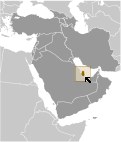World Atlas: Qatar. On this page you can see the map, country flag and many detailed information about the people, history and economy of Qatar.

Here you can find online selected information about the geography, inhabitants, government, economy and history of Qatar. Included are selected statistics, an overview map and the detailed map of Qatar. But let's start with the flag of Qatar here:
Qatar - Overview:
What you should know about Qatar? Let's start with this: Ruled by the Al Thani family since the mid-1800s, Qatar within the last 60 years transformed itself from a poor British protectorate noted mainly for pearling into an independent state with significant oil and natural gas revenues. The continuous siphoning off of petroleum revenue through the mid-1990s by Qatari amirs permanently residing in Europe had stunted Qatar’s economic growth. Former amir Hamad bin Khalifa Al Thani, who overthrew his father in a bloodless coup in 1995, ushered in wide-sweeping political and media reforms, unprecedented economic investment, and a growing Qatari regional leadership role, in part through the creation of the pan-Arab satellite news network Al-Jazeera and Qatar's mediation of some regional conflicts. In the 2000s, Qatar resolved its longstanding border disputes with both Bahrain and Saudi Arabia and by 2007 had attained the highest per capita income in the world. Qatar did not experience domestic unrest or violence like that seen in other Near Eastern and North African countries in 2010-11, due in part to its immense wealth. In mid-2013, Hamad peacefully abdicated, transferring power to his son, the current Amir Tamim bin Hamad. Tamim remains popular with the Qatari public, having prioritized improving the domestic welfare of Qataris, including establishing advanced healthcare and education systems and expanding the country's infrastructure in anticipation of Doha's hosting of the 2022 World Cup. Recently, Qatar’s relationships with its neighbors have been tense at times. Following the outbreak of regional unrest in 2011, Doha prided itself on its support for many popular revolutions, particularly in Libya and Syria. This stance was to the detriment of Qatar’s relations with Bahrain, Saudi Arabia, and the United Arab Emirates (UAE), which temporarily recalled their respective ambassadors from Doha in March 2014. Tamim later oversaw a warming of Qatar’s relations with Bahrain, Saudi Arabia, and the UAE in November 2014 following Kuwaiti mediation and signing of the Riyadh Agreement. In June 2017, however, the Quartet — Bahrain, Egypt, Saudi Arabia, and the UAE — cut diplomatic and economic ties with Qatar in response to alleged violations of the agreement.
Geography of Qatar
 Where on the globe is Qatar? The location of this country is Middle East, peninsula bordering the Persian Gulf and Saudi Arabia. Total area of Qatar is 11,586 sq km, of which 11,586 sq km is land. So this is quite a small country. How could we describe the terrain of the country? This way: mostly flat and barren desert. The lowest point of Qatar is Persian Gulf 0 m, the highest point Tuwayyir al Hamir 103 m. And the climate is arid; mild, pleasant winters; very hot, humid summers.
Where on the globe is Qatar? The location of this country is Middle East, peninsula bordering the Persian Gulf and Saudi Arabia. Total area of Qatar is 11,586 sq km, of which 11,586 sq km is land. So this is quite a small country. How could we describe the terrain of the country? This way: mostly flat and barren desert. The lowest point of Qatar is Persian Gulf 0 m, the highest point Tuwayyir al Hamir 103 m. And the climate is arid; mild, pleasant winters; very hot, humid summers.
Inhabitants of Qatar
Let's take a look how many people live in Qatar. The number is: 2,314,307 (July 2017 est.). So this is not very populous country. Who lives here? non-Qatari 88.4%, Qatari 11.6% (2015 est.). What are the languages in Qatar? Arabic (official), English commonly used as a second language. And the religions: Muslim 67.7%, Christian 13.8%, Hindu 13.8%, Buddhist 3.1%, folk religion . How old are the people in average? 33.2 years. We have to add that this number is the median - so one half of the people is older than this, one half is younger. And what is their life expectancy (at birth)? This: 78.9 years. Where the people live in Qatar? Here: most of the population is clustered in or around the capital of Doha on the eastern side of the peninsula. The major urban areas of Qatar are: DOHA (capital) 718,000 (2015).
Government and Economy of Qatar
The capital of Qatar is Doha and the government type absolute monarchy. Let's take a look at the administrative divisions - 8 municipalities (baladiyat, singular - baladiyah); Ad Dawhah, Al Khawr wa adh Dhakhirah, Al Wakrah, Ar Rayyan, Ash Shamal, Ash Shihaniyah, Az Za'ayin, Umm Salal. Regarding the economy of Qatar, important industrial products are liquefied natural gas, crude oil production and refining, ammonia, fertilizer, petrochemicals, steel reinforcing bars, cement, commercial ship repai. Important agricultural products are fruits, vegetables; poultry, dairy products, beef; fish. The most important export commodities are liquefied natural gas (LNG), petroleum products, fertilizers, steel and the most important export partners are Japan 20%, South Korea 15.5%, India 13.1%, China 8.2%, UAE 5.5%, Singapore 5.3% (2016). The most important import commodities are machinery and transport equipment, food, chemicals and the most important import partners are US 13.7%, Germany 9.8%, UAE 9.2%, China 8.6%, Japan 7.2%, UK 5.5%, Saudi Arabia 4.6%, Italy 4.4% (2016). How rich is Qatar and how rich are people in this country? The most important number here is GDP per capita (PPP): $124,900 (2017 est.). So the people are extremely rich on average here. Let's add that this means Gross Domestic Product per person, which is recalculated with respect to the relative cost of local goods and services. And one more important number - population below poverty line: NA%.